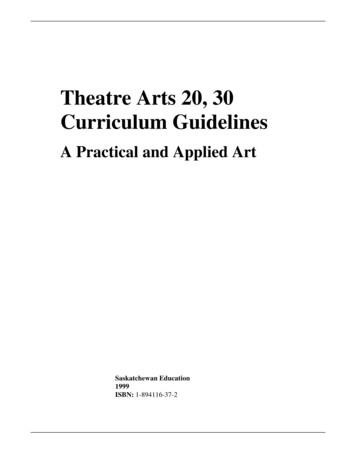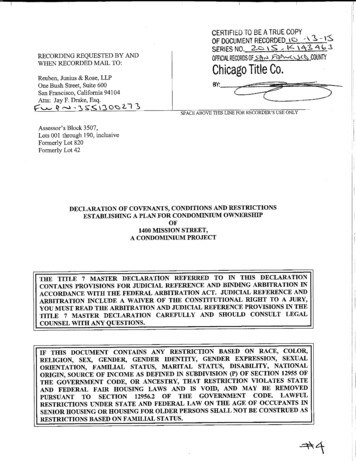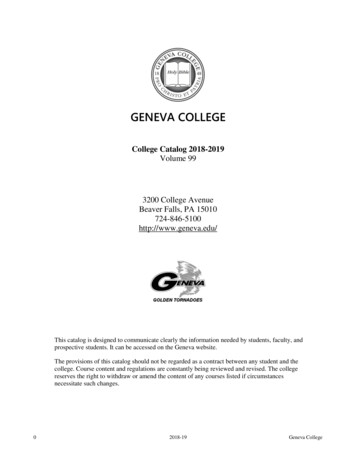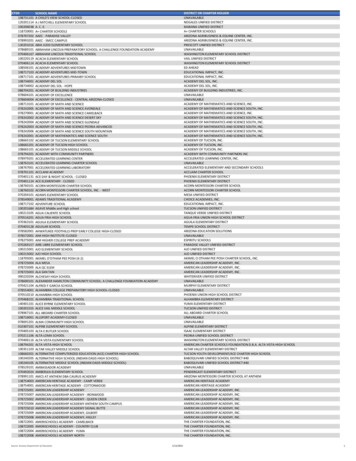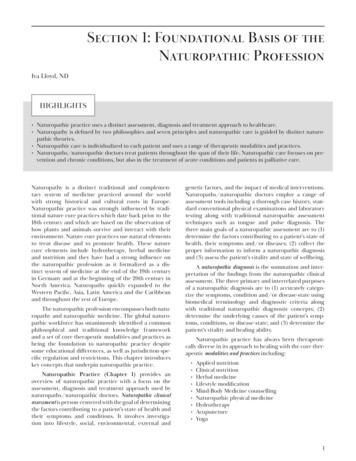
Transcription
Section 1: Foundational Basis of theNaturopathic ProfessionIva Lloyd, NDHIGHLIGHTS Naturopathic practice uses a distinct assessment, diagnosis and treatment approach to healthcare. Naturopathy is defined by two philosophies and seven principles and naturopathic care is guided by distinct naturopathic theories. Naturopathic care is individualized to each patient and uses a range of therapeutic modalities and practices. Naturopaths/naturopathic doctors treat patients throughout the span of their life. Naturopathic care focuses on prevention and chronic conditions, but also in the treatment of acute conditions and patients in palliative care.Naturopathy is a distinct traditional and complementary system of medicine practiced around the worldwith strong historical and cultural roots in Europe.Naturopathic practice was strongly influenced by traditional nature cure practices which date back prior to the18th century and which are based on the observation ofhow plants and animals survive and interact with theirenvironment. Nature cure practices use natural elementsto treat disease and to promote health. These naturecure elements include hydrotherapy, herbal medicineand nutrition and they have had a strong influence onthe naturopathic profession as it formalized as a distinct system of medicine at the end of the 19th centuryin Germany and at the beginning of the 20th century inNorth America. Naturopathy quickly expanded to theWestern Pacific, Asia, Latin America and the Caribbeanand throughout the rest of Europe.The naturopathic profession encompasses both naturopathy and naturopathic medicine. The global naturopathic workforce has unanimously identified a commonphilosophical and traditional knowledge frameworkand a set of core therapeutic modalities and practices asbeing the foundation to naturopathic practice despitesome educational differences, as well as jurisdiction-specific regulation and restrictions. This chapter introduceskey concepts that underpin naturopathic practice.Naturopathic Practice (Chapter 1) provides anoverview of naturopathic practice with a focus on theassessment, diagnosis and treatment approach used bynaturopaths/naturopathic doctors. Naturopathic clinicalassessment is person-centered with the goal of determiningthe factors contributing to a patient’s state of health andtheir symptoms and conditions. It involves investigation into lifestyle, social, environmental, external andgenetic factors, and the impact of medical interventions.Naturopaths/naturopathic doctors employ a range ofassessment tools including a thorough case history, standard conventional physical examinations and laboratorytesting along with traditional naturopathic assessmenttechniques such as tongue and pulse diagnosis. Thethree main goals of a naturopathic assessment are to (1)determine the factors contributing to a patient’s state ofhealth, their symptoms and/or diseases; (2) collect theproper information to inform a naturopathic diagnosisand (3) assess the patient’s vitality and state of wellbeing.A naturopathic diagnosis is the summation and interpretation of the findings from the naturopathic clinicalassessment. The three primary and interrelated purposesof a naturopathic diagnosis are to (1) accurately categorize the symptoms, condition and/or disease-state usingbiomedical terminology and diagnostic criteria alongwith traditional naturopathic diagnostic concepts; (2)determine the underlying causes of the patient’s symptoms, conditions, or disease-state; and (3) determine thepatient’s vitality and healing ability.Naturopathic practice has always been therapeutically diverse in its approach to healing with the core therapeutic modalities and practices including: Applied nutritionClinical nutritionHerbal medicineLifestyle modificationMind-Body Medicine counsellingNaturopathic physical medicineHydrotherapyAcupunctureYoga1
Section 1: Foundational Basis of the Naturopathic ProfessionOther therapies, such as Intravenous Therapies,regenerative therapies and other therapeutics may alsobe used by naturopaths/naturopathic doctors based onjurisdictional regulations and educational training.Naturopathic Theories (Chapter 3) outlines keytheoretical and conceptual frameworks that inform theclinical reasoning and decision making of naturopaths/naturopathic doctors. The main theories included are:Naturopathic Philosophies and Principles (Chapter2) outlines the philosophical basis that informs naturopathic practice. The naturopathic philosophies – vitalism(that there is an innate intelligence of living organisms)and holism (that the body is a complex adaptive systemthat exists as a unified whole) – encompass every aspectof naturopathic care. The seven naturopathic principlesalso guide naturopathic practice: The Naturopathic Therapeutic Order which is a systematic approach to treatment that moves fromminimally invasive to more forceful treatments asnecessary. The Emunctory Theory which outlines that toxic substances can be absorbed from the environment orproduced by abnormal metabolic processes and mustbe effectively eliminated to achieve good health. The Theory of Complex Systems which outlines that thebody is a complex and self-sustaining dynamic andevolving system functioning within an environmentof multiple nested systems which are interconnected,and treatment must reflect this.I. First, Do No Harm (primum non nocere)II. Healing Power of Nature (vis medicatrix naturae)III. Treat the Cause (tolle causam)IV. Treat the Whole Person (tolle totum)V. Doctor as Teacher (docere)VI. Health Promotion and Disease PreventionVII. Wellness and Wellbeing2
1Naturopathic PracticeIva Lloyd, NDTina Hausser, Heilpraktiker NaturopathHIGHLIGHTS Naturopathic assessment is a person-centered process that focuses on assessing a patient’s health status, on identifyingfactors contributing to patient symptoms and/or diseases and on assessing a patient’s vitality and wellbeing. Naturopathic diagnosis draws upon biomedical and traditional profession-specific diagnostic methods to understanda patient’s health status and to determine the underlying causes, as well as a patient’s vitality and sense of wellbeing. The naturopathic workforce employs a range of treatment modalities in their individualized and multi-modal integrative approach to patient care. It is common for naturopaths/NDs to perform or prescribe four or more different treatments during a naturopathicvisit. The most common therapeutic modalities used internationally by naturopaths/NDs are lifestyle modification, appliednutrition, clinical nutrition, and herbal medicine.Naturopathy/naturopathic medicine is a distinct healthcare system with a defined approach specific to naturopathic assessment, diagnosis, and treatment. There is ahigh degree of consistency in the foundational basis ofnaturopathic practice, but there are educational andregulatory variances in each country that result in differences in the breadth of assessments performed by naturopaths/naturopathic doctors, their ability to providepatients with a naturopathic diagnosis, and in the therapeutic modalities and practices used by naturopaths/naturopathic doctors (NDs).Naturopathic AssessmentThe naturopathic clinical assessment is a person-centredprocess focused on determining how a patient’s symptoms, condition and disease-state are presenting on themultidimensional levels of the individual and their socialinteractions. There are three distinct goals to a naturopathic assessment [1, 2].1. Determining the factors contributing to a patient’sstate of health, their symptoms and/or diseases.2. Collecting the proper information to inform anaturopathic diagnosis.3. Assessing the patient’s vitality and state ofwellbeing.When treating the whole person, a naturopathicassessment incorporates the comprehensive range offactors encompassed by the Treat the Cause (tolle causam)principle. These include addressing lifestyle factors (e.g.nutritional status, hydration, posture, sleep, breathing,hygiene, movement); family history and genetic factors;social interactions (e.g. family dynamics, community andschool or work factors, mental and emotional status);environmental factors (e.g. exposure to environmentalpollutants, pathogens, and time spent outside); externalinfluences (e.g. accidents and injuries, life events, hobbies, exposure to electromagnetic frequency devices andtoxins in household and personal products); and medicaltreatments (e.g. medications and supplements, history ofsurgeries and medical treatments) [1, 2].Naturopathic assessments are commonly longerthan visits with biomedical practitioners and emphasise a holistic patient-centered approach that considersthe patient’s perspective and their experience of theirhealth condition [3]. Naturopaths/naturopathic doctors employ methods of assessment and diagnosis drawndirectly from naturopathic training, other traditionaland complementary systems of healthcare, and biomedicine. The training and scope of practice, and the specificregulation in each jurisdiction influences the specificassessment tools employed and a naturopaths/naturopathic doctor’s ability to diagnose. Generally speaking, anaturopathic assessment includes [1]: Detailed personal and health history. Assessment of a patient’s diet and nutritional status,3
Section 1: Foundational Basis of the Naturopathic Professionlevel of exercise and other lifestyle factors. Assessment of a patient’s mental and emotionalstatus and sense of wellbeing. Assessment of the emunctory pathways. Information related to environmental exposuresand unique environmental conditions associatedwith where the person lives and has lived. History of previous accidents, injuries, externalinfluences, medical procedures, prescription medications and surgeries and the potential for contraindications when using naturopathic treatments. Diagnostic techniques may include tongue, iris, andpulse diagnosis as well as other diagnostic methodsconsistent with the training and scope of practice ineach Region.1 A physical examination using traditional and biomedical diagnostic methods.2 Laboratory testing.3 Referral to another allied healthcare professional orspecialist for aspects of the assessment may occur,depending on the scope of practice in each jurisdiction and the specific needs of each patient.Naturopathic DiagnosisA naturopathic diagnosis is the summation and interpretation of the findings from the naturopathic clinicalassessment. Naturopaths/naturopathic doctors combineevidence-based biomedical approaches to diagnosticswith traditional profession-specific diagnostic methods.There are three primary and interrelated purposes to anaturopathic diagnosis [1]:1. To accurately categorize the symptoms, conditionand/or disease-state using traditional naturopathicdiagnostic concepts along with biomedical terminology and diagnostic criteria.2. To determine the underlying causes of the patient’ssymptoms, conditions, or disease-state.3. To determine the patient’s vitality and healingability.Naturopathic practice recognizes that health anddisease are a continuum, and in the absence of a clearlydefined conventional diagnosis, a naturopathic diagnosismay classify a patient’s symptoms based on the characteristic pattern of their symptoms and the causal factors.It is important to note that in some jurisdictions,naturopaths/naturopathic doctors’ use of the termsdiagnosis and diseases are restricted and, hence, the1234naturopathic diagnosis in these Regions focuses more onthe assessment of health status, characteristic (or constitutional) patterns and the causes of diseases.Therapeutic Modalitiesand PracticesNaturopathic care is an integrative clinical practice tailored to each individual patient based on the uniquefactors identified in the naturopathic assessment andclassified in the naturopathic diagnosis. Naturopathicpractice has always been known for its range of practicesand treatment modalities [1]. Naturopaths/naturopathicdoctors recognize that an integrated approach to healingand disease management provides the best foundationfor optimal health and that focusing on changes thatpatients can integrate into their life, including a greatersense of wellbeing and self-care, are important aspectsof naturopathic care [1]. It is common for naturopaths/naturopathic doctors to perform or prescribe four ormore different treatments during a naturopathic visit [4].A 2021 international survey across all WHO Regionsinvestigated the practice characteristics and behavioursof naturopaths/naturopathic doctors [3]. The studyfound naturopaths/naturopathic doctors ‘always’ or‘most of the time’ reported prescribing or recommendinglifestyle modifications, dietary changes, nutritional supplements and herbal medicines. Counselling and psychotherapy, and manual therapies were also reportedby more than one quarter of naturopaths/naturopathicdoctors. Most naturopaths/naturopathic doctors reportdiscussing a range of topics with their patients includingdiet and nutrition, stress management, sleep, physicalactivity and fitness, pharmaceuticals and other medications, substance use, counselling and mental health,relationships and support, and environmental health andtoxins. The full list of practice behaviours is presented inTable 1.1. These survey findings align with other researchconducted by the WNF [1, 4, 5].A strength of the naturopathic integrated approachto healthcare is its ability to incorporate practices andtherapeutic modalities based on regional traditionalhealthcare practices, on the level of education and regulation in each jurisdiction and based on the unique characteristics of each patient. In Regions that include highernaturopathic educational training and a supportive regulatory environment, naturopathic practice may includeNaturopathic practitioners in Europe are commonly trained in iris analysis (‘iridology’). Naturopaths in many WHORegions include tongue and pulse diagnosis as part of their naturopathic training.In some jurisdictions such as North America, naturopathic doctors are trained as primary care practitioners and theirscope of practice includes gynecological and pelvic exams, along with standard physical exams.Laboratory testing can include standard blood and urine tests, hair mineral analysis, detailed testing of stool, saliva,and other secretions. Some naturopathic doctors are also trained to interpret radiological reports and scans as part oftheir assessment.
Chapter 1: Naturopathic PracticeTable 1.1: Frequency naturopaths/naturopathic doctors report engaging in practice behaviours ‘always’ or ‘most of thetime’ (n 478)Practice behaviourAlways/Most of the timePrescription/recommendationN (%)Lifestyle modification437 (91.4%)Dietary changes429 (89.8%)Nutritional supplements308 (64.4%)Herbal medicines287 (60.0%)Counselling and psychotherapy132 (27.7%)Manual therapies127 (26.5%)Acupuncture78 (16.3%)Hydrotherapy72 (15.1%)Other traditional medicine systems69 (14.5%)Homeopathy67 (14.1%)Injection/intravenous therapies28 (5.9%)Discussion topicStress management432 (90.8%)Diet and nutrition429 (90.1%)Sleep422 (88.6%)Physical activity and fitness422 (88.6%)Pharmaceuticals and other medication302 (63.6%)Counselling and mental health302 (63.4%)Relationships and support286 (60.2%)Substance use272 (57.2%)Environmental health and toxins234 (49.2%)therapies such as prescribing rights for pharmaceuticals,bio-identical hormone prescribing, intravenous therapies, regenerative injective therapies, and minor surgery.In addition to the clinical value of specific naturopathic treatments, patients may also benefit non-specifichealing effects associated with the quality and nature ofthe naturopathic consultation [6]. More details about thenaturopathic philosophies and principles are described inChapter 2. Section 6 also presents a summary of clinicalresearch investigating outcomes of specific naturopathictherapies and practices, including clinical trials thatcontrol for non-specific healing effects. The therapeuticmodalities and practices further explored in Section 6are outlined below.Applied nutrition involves the modification of dietarypatterns and food choices with the goal of optimizingnutritional status in the treatment and/or prevention ofdisease. Naturopathic applied nutritional interventionsinclude diet therapy (therapeutic diets, fasting and individualized diet modification), therapeutic application ofspecific foods and behavioural and lifestyle counsellingrelated to eating behaviours [7]. Naturopathic practiceincorporates the scientific and empirical knowledgeof food and nutrition, it recognizes the value of wholefoods beyond their individual constituents, as well asthe traditional knowledge of food as a form of medicineand the importance of considering the constitution anduniqueness of every patient, the thoughts, and emotionsthat they have around food and where they live.Clinical nutrition is the use of therapeutic products(e.g., tablets, powders and liquids) of vitamins, minerals and food-based extracts with health-promoting,disease-preventing or medicinal properties for targetedclinical outcomes [8]. Naturopaths/naturopathic doctors may employ clinical nutrition interventions toaddress identified nutritional insufficiencies, or to initiate biochemical or physiological changes in response tothe patient’s specific health conditions or complaints [9].Clinical nutrition can be applied by increasing levels of awide range of vitamins and minerals (e.g., multivitamins);the application of specialized formulas developed forexplicit health purposes and effects; or the use of singlenutrients targeting specific patient needs. Naturopaths/naturopathic doctors may recommend or prescribe commercially-produced nutritional products, or extemporaneous dispense compounded nutritional ingredientsformulated specifically for the individual patient [9, 10].Herbal medicine ranges from herbs as food, the prescription of single herbs (either in whole form or various extracts or the use of unaltered constituents from5
Section 1: Foundational Basis of the Naturopathic Professionthese sources) and compounded formulations with morethan one herbal remedy. Herbs may be prescribed aspre-formulated proprietary products (i.e., commerciallyproduced formulas), or dispensed extemporaneously(i.e., compounded onsite for the specific needs of theindividual patient). Herbs can be prescribed internallyas part of diet, as teas, tinctures, essential oils, or tablets/capsules, and can also be used topically in creams,oils and in poultices and compresses. Also referred to asbotanical medicine, phytotherapy or phytomedicine.Lifestyle modification consists of the application ofenvironmental, psychological, and behavioural principles to enhance wellbeing. These principles may beapplied through exercise prescription and posturalawareness; the modification of diet; advocation for minimized exposure to tobacco smoking, alcohol, and otherillicit substances; and guidelines for the regulation of thesleep-wake cycle through addressing work-rest balanceand recreation [11]. Significant considerations of notealso include activity scheduling, which encourages meaningful social engagement [12]. Environmental factors arealso significant considerations and may be targeted byadvocating for reduced exposure to air, water, and noisepollution, and encouraging time spent in nature.Mind-Body Medicine (MBM) Counselling comprisesa variety of practices designed to enhance the mind’spositive impact on the body and vice versa, includingbehavioural, psychological, social, artistic, and spiritualapproaches [13, 14]. The practice of MBM is based onthe understanding that the mind influences the physicalbody and conversely the physical influences the state ofthe mind. MBM practices include yoga, tai chi, or meditation, which have been part of traditional medicine forseveral hundred to thousand years and more recent practices such as mindfulness stress reduction (MBSR).Naturopathic physical medicine includes various formsof hands-on therapies ranging from muscle release andmassage techniques, physical manipulation, and otherbodywork techniques. Some naturopaths/naturopathicdoctors provide naturopathic physical medicine as partof their practice directly with patients while others workwith various bodywork practitioners to provide patientswith a holistic and an integrated approach to healthcare.Hydrotherapy is the application of water for therapeutic purposes. Hydrotherapy can be used externally,which includes compresses, baths (balneotherapy or thalassotherapy) and sprays; and internally, which includesinhalations and colon hydrotherapy [15]. It is a completely drugless therapy that supports the body’s healingprocesses primarily through the manipulation of bloodcirculation through thermic and mechanical means.Some therapies also use water as a medium for transferof minerals, herbal remedies or other therapeuticagents. The treatment effect of hydrotherapy is basedon the specific application of either cold or hot water or6the alternating of cold and hot water compresses and isdesigned to generally be sedative in acute disease andstimulative in chronic [16].Acupuncture is practiced in several different waysincluding needling, electroacupuncture, auricular acupuncture, acupressure, cupping and/or moxibustion.Needle acupuncture includes the insertion of needlesalong meridian channels on the body based on TraditionalChinese Medicine (TCM) philosophy. Auricular acupuncture is a technique whereby points in the ear are needledor where acupuncture ‘seeds’ or tiny needles are appliedto specific points on the ear. Acupressure uses the samephilosophical basis as acupuncture, but instead of needles,pressure is applied to acupuncture points. Acupressureallows practitioners with regulatory restrictions, to stillpractice a form of acupuncture. Cupping traditionallyuses continuous suction, but modern devices also allowfor pulsating suction or the sliding of cups along the skin.Other techniques that fall under TCM include moxibustion which is the burning of herbs near or on the body,Tui na, a therapeutic type of TCM massage, and Gua shatherapy, a healing method which involves scraping theskin. A stimulation pad or device is another modernmeans of using the principles of acupuncture for painrelief that may be safely applied at home.Yoga is a philosophically based practice and a blend ofphysical and mental disciplines. Traditionally Yoga incorporates physical asanas (postures) and practices, but alsopranayama (breathing exercises), nidra (chanting), kriyas(cleansing activities), and dhyana (meditation), as well asother meditation, spirituality, and dietary and lifestylemodifications that support harmony and balance withinthe whole person. The term Yoga refers to both the entireprocess of these practices and the goal or end-point philosophically [17].SummaryNaturopaths/naturopathic doctors treat patients acrosstheir lifespan, including those with acute and chronicconditions and those seeking preventive and/or palliative healthcare. Naturopathic practice is person-centeredwith a detailed focus on the assessment process and onidentifying the causes of disease as part of a naturopathicdiagnosis. Naturopathic practice is defined by a cohesivephilosophical and principles-based foundation and naturopathic care employs a range of therapies and practicesto meet individual treatment goals. Common therapeuticmodalities and practices employed by naturopaths andnaturopathic doctors include applied nutrition, clinical nutrition, herbal medicines, lifestyle counselling,hydrotherapy, naturopathic physical medicine, and othertherapies and practices depending on jurisdictional regulations and naturopathic medical training.
Chapter 1: Naturopathic PracticeLiterature Cited1. Hausser, T., Lloyd, I., Yánez, J., Cottingham, P., Newman-Turner, R., and Abascal, A. WNF White Paper:Naturopathic Philosophies, Principles and Theories. 2017;Available from: uploads/2015/12/White-PaperFINAL.pdf.2. Lloyd, I., The History of Naturopathic Medicine: A CanadianPerspective. 2009: McArthur & Company.3. Steel, A., Leach, M., Brosnan C, Ward V, and Lloyd, I.,Naturopaths’ mobilization of knowledge and information inclinical practice: an international cross-sectional survey. BMCComplementary Medicine and Therapies, 2021.4. Steel, A., Foley, H., Bradley, R., Van De Venter, C., Lloyd,I., Schloss, J., Wardle, J., and Reid, R., Overview of international naturopathic practice and patient characteristics: resultsfrom a cross-sectional study in 14 countries. BMC Complementary Medicine and Therapies, 2020. 20(1): p. 59.5. World Naturopathic Federation. The World Naturopathic Federation Roots Report – Findings from the naturopathic roots committee survey. 2016; Available lications/.6. Graham, K.D., Steel, A., and Wardle, J., The Intersectionbetween Models of Health and How Healing Transpires: AMetaethnographic Synthesis of Complementary Medicine Practitioners’ Perceptions. Journal of Alternative and Complementary Medicine, 2021.7. Zeff, J., Snider, P., and Myers, S.P., A Hierarchy of Healing:The Therapeutic Order, in Textbook of Natural Medicine, J.M.Pizzorno, Michael, Editor. 2013, Elselvier.8. World Naturopathic Federation. Defining the GlobalNaturopathic Profession. 2017; Available from: rofession WNF-2017 .pdf.9. Sarris, J. and Wardle, J., eds. Clinical naturopathy: an evidence-based guide to practice. 3rd ed. 2019, Elsevier HealthSciences: Chatswood, NSW.10. Steel, A., Schloss, J., Leach, M., and Adams, J., The naturopathic profession in Australia: A secondary analysis of thePractitioner Research and Collaboration Initiative (PRACI).Complementary Therapies in Clinical Practice, 2020. 40:p. 101220.11. Walsh, R., Lifestyle and Mental Health. American Psychologist, 2011.12. Hidaka, B.H., Depression as a disease of modernity: explanations for increasing prevalence. Journal of Affective Disorders, 2012. 140(3): p. 205-14.13. National Cancer Institute. Mind-body practice. 2018;Available from: ancer-terms/def/mind-body-practice.14. Lauche, R. and Cramer, H., Mind-body therapies: Connecting the parts and embracing diversity. Complementarytherapies in medicine, 2018. 40: p. 214.15. Turner, R.N., Naturopathic Medicine: Treating the WholePerson. 1984: Thorsons.16. Lindlahr, H., Natural Therapeutics Volume 2: Practice. 2004:Penguin Random House.17. Mallinson, J. and Singleton, M., Roots of Yoga. 2017: Penguin Books.7
2Naturopathic Philosophies andPrinciplesIva Lloyd, NDTina Hausser, Heilpraktiker NaturopathStephen Myers, ND PhDHIGHLIGHTS The naturopathic philosophies of vitalism (an innate intelligence of living organisms) and holism (the body is a complexadaptive system that exists as a unified whole) are core to naturopathic practice. There are seven naturopathic principles that guide every aspect of naturopathic care:I. First, Do No Harm (primum non nocere)II. Healing Power of Nature (vis medicatrix naturae)III. Treat the Cause (tolle causam)IV. Treat the Whole Person (tolle totum)V. Doctor as Teacher (docere)VI. Health Promotion and Disease PreventionVII. Wellness and WellbeingThe naturopathic profession shares historical and cultural roots with early Western medicine, and it hasbecome particularly adept at integration and translationwithin biomedical settings, whilst remaining true to itstraditional philosophies and principles. It is the integration of naturopathic philosophies and principles withina biomedical understanding of health and disease thatdefines the naturopathic profession. Applying naturaltherapeutic modalities and practices through the lensof naturopathic principles, philosophies and theories,rather than prescribing natural remedies using a biomedical approach, is what differentiates naturopathy/naturopathic medicine from other systems of medicines.NaturopathicPhilosophiesVitalism and holism are the core naturopathic philosophiesthat guide every aspect of naturopathic care [1-3].VitalismVitalism is based on the concept that living organismsare fundamentally different from non-living entities inthat the origin and phenomena of life involves a force or8energy distinct from and in addition to the physical orchemical elements of life [4]. The application of vitalismwithin naturopathy/naturopathic medicine is based onthe understanding that the body has an innate ability toheal, and that life, health and disease follow certain lawsand principles that are logical and innate [1, 5]. Vitalismpostulates that there is a self-organizing principle withinall life and recognizes that life is ordered and intelligent[1, 6]. The innate intelligence of the human body animates every individual and refers to forces that not onlyinclude but go beyond the physical or chemical self ingoverning life, health, and healing. Naturopathic practice aims to facilitate and augment this process by identifying and removing the obstacles to health and recovery,and by supporting the creation of healthy internal andexternal environments [6].HolismThe philosophy of holism underpins naturopathic practiceand recognizes that to achieve health the whole personmust be treated. Holistic/holism means ‘all’, ‘entire’ or‘total’. It is grounded in the realization that the whole isgreater than the sum of the parts [1, 5, 7] and that thebody is a complex adaptive system that exists as a unifiedwhole and must be dealt with as an integrated model in
Chapter 2: Naturopathic Philosophies and Principlesorder to be fully understood [8].The holistic approach of naturopathic practice recognizes that the spiritual, psychological, functional,and structural aspects of a person are interdependent.Whe
naturopathic diagnosis in these Regions focuses more on the assessment of health status, characteristic (or consti-tutional) patterns and the causes of diseases. Therapeutic Modalities and Practices Naturopathic care is an integrative clinical practice tai-lored to each individual patient based on the unique



